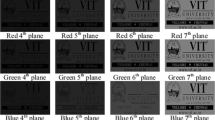Abstract
Protection of digital contents yields more attention towards society. The proposed approach aims to authenticate the video based on the horizontal concatenation approach. Initially, the selected video frame isolates the luminance, chrominance red, and chrominance blue layers. Further, slice each layer and concatenate them slice horizontally. Now focus on the middle region concatenated layered image and introduce the single level wavelet transform. A watermark image is divided vertically and one of the portions is concealed with vertically half of the approximation band (LL1), it merged similarly another half of the watermark image with vertically half of the medium level band (LH1). In this approach, the different scaling factor values (α =0.1 and β = 0.01) are used to achieve better PSNR. Apply the Inverse Discrete Wavelet Transform to bring back the normal concatenated frames. Next, group the luminance, chrominance red, and chrominance blue layers and stack to gain the marked video frame. Since this strategy is a non-blind technique, hence the copyright image can be established by using the same procedure of watermarked and non watermarked video frames. This approach aims to minimize the bit error rate and enhances the robustness.









Similar content being viewed by others
References
Asikuzzaman M, Alam MJ, Lambert AJ, Pickering MR (2014) Imperceptible and robust blind video watermarking using chrominance embedding: a set of approaches in the DT CWT domain. IEEE Trans Info Foren Secur 9(9):1502–1517
Busch C, Funk W, Wolthusen S (1999) Digital watermarking: from concepts to real time video applications. IEEE Trans Comp Graph Appl 19(1):25–35
Dolley S, Manisha S (2018) Robust scene-based digital video watermarking scheme using level-3 DWT: approach, evaluation and experimentation. Radioelectron Commun Syst 61(1):1–12
El’arbi M, Koubaa M, Charfeddine M, Amar CB (2011) A dynamic video watermarking algorithm in fast motion areas in the wavelet domain. Multimed Tools Appl 55(3):579–600
Jane O, Elbaşi E, Ilk HG (2014) Hybrid non-blind watermarking based on DWT and SVD. J Appl Res Technol 12(4):750–761
Khalil OH, Elhadad A, Ghareeb A (2020) A blind proposed 3D mesh watermarking technique for copyright protection. Imaging Sci J 68(2):90–99
Leelavathy N, Prasad EV, Kumar SS (2012) A scene based video watermarking in discrete multiwavelet domain. Int J Multidiscipl Sci Eng 3:12–16
Lei B, Zhao X, Lei H, Ni D, Siping C, Zhou F, Wang T (2017) Multipurpose watermarking scheme via intelligent method and chaotic map. Multimed Tools Appl 78:27085–27107
Liao X, Li K, Yin J (2017) Separable data hiding in encrypted image based on compressive sensing and discrete fourier transform. Multimed Tools Appl 76:20739–20753
Liao X, Yu Y, Li B, Li Z, Qin Z (2020) A new payload partition strategy in color image steganography. IEEE Trans Circuits Syst Video Technol 30(3):685–696
Liao X, Yin J, Chen M, Qin Z (2022) Adaptive payload distribution in multiple images steganography based on image texture features. IEEE Trans Dependable Secure Comput 19(2):897–911
Mallat S (1989) A theory for multi-resolution signal decomposition: The wavelet representation. IEEE Trans Pattern Anal Mach Intell 11(7):674–693
Masoumi M, Amiri S (2013) A blind scene-based watermarking for video copyright protection. AEU Int J Electron Commun 67(6):528–535
Mostafa S, Ali A (2016) A multiresolution video watermarking algorithm exploiting the block-based motion estimation. J Inf Secur Eng (JIS) 7(4):260–268
Mukherjee D, Maitra S, Acton ST (2004) Spatial domain digital watermarking of multimedia objects for buyer authentication. IEEE Trans Multimed 6(1):1–15
Nouioua I, Amardjia N, Belilita S (2018) A novel blind and robust video watermarking technique in fast motion frames based on SVD and MR-SVD. Secur Commun Netw 2018:1–17
Qiao L, Nahrstedt K (1988) Watermarking schemes and protocols for protecting rightful ownership and Customer's rights. J Vis Commun Image Represent 9(3):194–210
Rajab L, Al-Khatib T, Al-Haj A (2009) Video watermarking algorithms using the SVD transform. Eur J Sci Res 30(3):389–401
Reddy AA, Chatterji BN (2005) A new wavelet based logo watermarking scheme. Pattern Recogn Lett 26(7):1019–1027
Sang J, Liu Q, Song C-L (2020) Robust video watermarking using a hybrid DCT-DWT approach. J Electron Sci Technol 18(2):100052
Sridhar B (2018) A wavelet based watermarking approach in Concatenated Square block image for high security. J Autom Mob Robot Intell Syst 12(3):68–72
Sridhar B (2018) A wavelet based watermarking in video using layer fusion technique. Patt Recog Image Anal 28(3):537–545
Sridhar B, Arun C (2015) Secure video watermarking algorithm based on wavelet with multiple watermarks. Lat Am Appl Res 45(3):207–212
Sridhar B, Syambabu V (2021) Security enhancement in video based on gatefold technique for copyright protection. Multimed Tools Appl 80(6):8241–8256
Thanh TM, Hiep PT, Tam TM, Tanaka K (2014) Robust semi-blind video watermarking based on frame-patch matching. AEU Int J Electron Commun 68:1007–1015
Thind DK, Jindal S (2015) A semi blind DWT-SVD video watermarking. Procedia Comput Sci 46:1661–1667
Wang Y, Doherty JF, VanDyck RE (2002) A wavelet based watermarking algorithm for ownership verification of digital image. IEEE Trans Image Process 11(2):77–88
Ye D, Zou C, Dai Y, Wang Z (2007) A new adaptive watermarking for real-time MPEG videos. Appl Math Comput 185(2):907–918
Author information
Authors and Affiliations
Corresponding author
Ethics declarations
Conflict of interest
Author declares no conflict of interest.
Additional information
Publisher’s note
Springer Nature remains neutral with regard to jurisdictional claims in published maps and institutional affiliations.
Rights and permissions
Springer Nature or its licensor (e.g. a society or other partner) holds exclusive rights to this article under a publishing agreement with the author(s) or other rightsholder(s); author self-archiving of the accepted manuscript version of this article is solely governed by the terms of such publishing agreement and applicable law.
About this article
Cite this article
Sridhar, B. Authentication of video based on concatenated plane slicing layers approach. Multimed Tools Appl 82, 19657–19673 (2023). https://doi.org/10.1007/s11042-023-14426-w
Received:
Revised:
Accepted:
Published:
Issue Date:
DOI: https://doi.org/10.1007/s11042-023-14426-w




